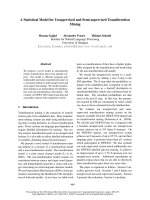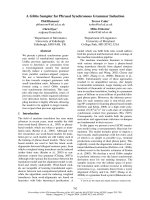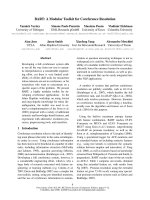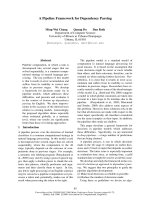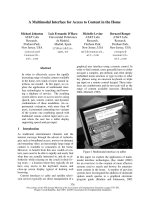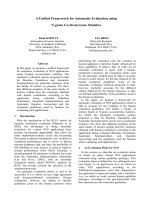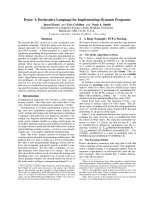Báo cáo khoa học: "A Knowledge-free Method for Capitalized Word Disambiguation" doc
Bạn đang xem bản rút gọn của tài liệu. Xem và tải ngay bản đầy đủ của tài liệu tại đây (808.21 KB, 8 trang )
A Knowledge-free Method for Capitalized Word Disambiguation
Andrei Mikheev*
Harlequin Ltd., Lismore House, 127 George Street, Edinburgh EH72 4JN, UK
mikheev@harlequin,
co. uk
Abstract
In this paper we present an approach to the dis-
ambiguation of capitalized words when they are
used in the positions where capitalization is ex-
pected, such as the first word in a sentence or
after a period, quotes, etc Such words can act
as proper names or can be just capitalized vari-
ants of common words. The main feature of
our approach is that it uses a minimum of pre-
built resources and tries to dynamically infer
the disambiguation clues from the entire docu-
ment. The approach was thoroughly tested and
achieved about 98.5% accuracy on unseen texts
from The New York Times 1996 corpus.
1 Introduction
Disambiguation of capitalized words in mixed-
case texts has hardly received much attention
in the natural language processing and infor-
mation retrieval communities, but in fact it
plays an important role in many tasks. Cap-
italized words usually denote proper names -
names of organizations, locations, people, arti-
facts, etc. - but there are also other positions in
the text where capitalization is expected. Such
ambiguous positions include the first word in
a sentence, words in all-capitalized titles or ta-
ble entries, a capitalized word after a colon or
open quote, the first capitalized word in a list-
entry, etc. Capitalized words in these and some
other positions present a case of ambiguity -
they can stand for proper names as in "White
later said ", or they can be just capitalized
common words as in "White elephants are ".
Thus the disambiguation of capitalized words in
the ambiguous positions leads to the identifica-
tion of proper names I and in this paper we will
* Also at
HCRC,
University of Edinburgh
1This is not entirely true - adjectives derived from lo-
cations such as American, French, etc., are always writ-
use these two terms interchangeably. Note that
this task, does not involve the classification of
proper names into semantic categories (person,
organization, location, etc.) which is the objec-
tive of the Named Entity Recognition task.
Many researchers observed that commonly
used upper/lower case normalization does not
necessarily help document retrieval. Church in
(Church, 1995) among other simple text nor-
malization techniques studied the effect of case
normalization for different words and showed
that " sometimes case variants refer to the
same thing
(hurricane
and
Hurricane),
some-
times they refer to different things
(continental
and
Continental)
and sometimes they don't re-
fer to much of anything (e.g.
anytime
and
Any-
time)."
Obviously these differences are due to
the fact that some capitalized words stand for
proper names (such as
Continental-
the name
of an airline) and some don't.
Proper names are the main concern of the
Named Entity Recognition subtask (Chinchor,
1998) of Information Extraction. There the dis-
ambiguation of the first word of a sentence (and
in other ambiguous positions) is one of the cen-
tral problems. For instance, the word "Black"
in the sentence-initial position can stand for
a person's surname but can also refer to the
colour. Even in multi-word capitalized phrases
the first word can belong to the rest of the
phrase or can be just an external modifier. In
the sentence "Daily, Mason and Partners lost
their court case" it is clear that "Daily, Mason
and Partners" is the name of a company. In the
sentence "Unfortunately, Mason and Partners
lost their court case" the name of the company
does not involve the word "unfortunately", but
ten capitalized but in fact can stand for an adjective
(American president) as
well as a proper noun
(he was
an American).
159
the word "Daily" is just as common a word as
"unfortunately".
Identification of proper names is also impor-
tant in Machine Translation because normally
proper names should be transliterated (i.e. pho-
netically translated) rather than properly (se-
mantically) translated. In confidential texts,
such as medical records, proper names must be
identified and removed before making such texts
available to unauthorized people. And in gen-
eral, most of the tasks which involve different
kinds of text analysis will benefit from the ro-
bust disambiguation of capitalized words into
proper names and capitalized common words.
Despite the obvious importance of this prob-
lem, it was always considered part of larger
tasks and, to the authors' knowledge, was not
studied closely with full attention. In the part-
of-speech tagging field, the disambiguation of
capitalized words is treated similarly to the
disambiguation of common words. However,
as Church (1988) rightly pointed out "Proper
nouns and capitalized words are particularly
problematic: some capitalized words are proper
nouns and some are not. Estimates from the
Brown Corpus can be misleading. For exam-
ple, the capitalized word "Acts" is found twice
in Brown Corpus, both times as a proper noun
(in a title). It would be misleading to infer
from this evidence that the word "Acts" is al-
ways a proper noun." Church then proposed to
include only high frequency capitalized words
in the lexicon and also label words as proper
nouns if they are "adjacent to" other capital-
ized words. For the rest of capitalized common
words he suggested that a small probability of
proper noun interpretation should be assumed
and then one should hope that the surrounding
context will help to make the right assignment.
This approach is successful for some cases but,
as we pointed out above, a sentence-initial cap-
italized word which is adjacent to other capital-
ized words is not necessarily a part of a proper
name, and also many common nouns and plural
nouns can be used as proper names (e.g. Rid-
ers) and their contextual expectations are not
too different from their usual parts of speech.
In the Information Extraction field the dis-
ambiguation of capitalized words in the am-
biguous positions was always tightly linked to
the classification of the proper names into se-
mantic classes such as person name, location,
company name, etc. and to the resolution of
coreference between the identified and classi-
fied proper names. This gave rise to the meth-
ods which aim at these tasks simultaneously.
(Mani&MacMillan, 1995) describe a method
of using contextual clues such as appositives
("PERSON,
the daughter of a prominent local
physician") and felicity conditions for identify-
ing names. The contextual clues themselves are
then tapped for data concerning the referents
of the names. The advantage of this approach
is that these contextual clues not only indicate
whether a capitalized word is a proper name,
but they also determine its semantic class. The
disadvantage of this method is in the cost and
difficulty of building a wide-coverage set of con-
textual clues and the dependence of these con-
textual clues on the domain and text genre.
Contextual clues are very sensitive to the spe-
cific lexical and syntactic constructions and the
clues developed for the news-wire texts are not
useful for legal or medical texts.
In this paper we present a novel approach to
the problem of capitalized word disambiguation.
The main feature of our approach is that it uses
a minimum of pre-built resources and tries to
dynamically infer the disambiguation clues from
the entire document under processing. This
makes our approach domain and genre inde-
pendent and thus inexpensive to apply when
dealing with unrestricted texts. This approach
was used in a named entity recognition system
(Mikheev et al., 1998) where it proved to be
one of the key factors in the system achieving a
nearly human performance in the 7th Message
Understanding Conference (MUC'7) evaluation
(Chinchor, 1998).
2 Bottom-Line Performance
In general, the disambiguation of capitalized
words in the mixed case texts doesn't seem to
be too difficult: if a word is capitalized in an un-
ambiguous position, e.g., not after a period or
other punctuation which might require the fol-
lowing word to be capitalized (such as quotes or
brackets), it is a proper name or part of a multi-
word proper name. However, when a capitalized
word is used in a position where it is expected
to be capitalized, for instance, after a period or
in a title, our task is to decide whether it acts
160
Total Words
Proper Names
Common Words
All Words
tokens types
2,677 665
826 339
1,851 326
Known Words
tokens types
2,012 384
171 68
1,841 316
Unknown Words
tokens types
665 281
655 271
10 10
Table 1: Distribution of capitalized word-tokens/word-types in the ambiguous positions.
as a proper name or as the expected capitalized
common word.
The first obvious strategy for deciding
whether a capitalized word in an ambiguous po-
sition is a proper name or not is to apply lexi-
con lookup (possibly enhanced with a morpho-
logical word guesser, e.g., (Mikheev, 1997)) and
mark as proper names the words which are not
listed in the lexicon of common words. Let us
investigate this strategy in more detail: In our
experiments we used a corpus of 100 documents
(64,337 words) from The New York Times 1996.
This corpus was balanced to represent different
domains and was used for the formal test run
of the 7th Message Understanding Conference
(MUC'7) (Chinchor, 1998) in the Named En-
tity Recognition task.
First we ran a simple zoner which identi-
fied ambiguous positions for capitalized words -
capitalized words after a period, quotes, colon,
semicolon, in all-capital sentences and titles
and in the beginnings of itemized list entries.
The 64,337-word corpus contained 2,677 cap-
italized words in ambiguous positions, out of
which 2,012 were listed in the lexicon of En-
glish common words. Ten common words were
not listed in the lexicon and not guessed by our
morphological guesser: "Forecasters", "Bench-
mark", "Eeverybody", "Liftoff", "Download-
ing", "Pretax", "Hailing", "Birdbrain", "Opt-
ing" and "Standalone". In all our experiments
we did not try to disambiguate between singu-
• lar and plural proper names and we also did
not count as an error the adjectival reading of
words which are always written capitalized (e.g.
American, Russian, Okinawian, etc.). The dis-
tribution of proper names among the ambiguous
capitalized words is shown in Table 1.
Table 1 allows one to estimate the perfor-
mance of the lexicon lookup strategy which we
take as the bottom-line. First, using this strat-
egy we would wrongly assign the ten common
words which were not listed in the lexicon. More
damaging is the biind assignment of the com-
mon word category to the words listed in the
lexicon: out of 2,012 known word-tokens 171
actually were used as proper names. This in to-
tal would give us 181 errors out of 2,677 tries
-
about a 6.76% misclassification error on capi-
talized word-tokens in the ambiguous positions.
The lexicon lookup strategy can be enhanced
by accounting for the immediate context of the
capitalized words in question. However, cap-
italized words in the ambiguous positions are
not easily disambiguated by their surrounding
part-of-speech context as attempted by part-of-
speech taggers. For instance, many surnames
are at the same time nouns or plural nouns in
English and thus in both variants can be fol-
lowed by a past tense verb. Capitalized words
in the phrases
Sails rose
or
Feeling him-
sell ,
can easily be interpreted either way and
only knowledge of semantics disallows the plural
noun interpretation of
Stars can read.
Another challenge is to decide whether the
first capitalized word belongs to the group of the
following proper nouns or is an external modifier
and therefore not a proper noun. For instance,
All American Bank
is a single phrase but in
All
State Police
the word "All" is an external mod-
ifier and can be safely decapitalized. One might
argue that a part-of-speech tagger can capture
that in the first case the word "All" modified a
singular proper noun ("Bank") and hence is not
grammatical as an external modifier and in the
second case it is a grammatical external modi-
fier since it modifies a plural proper noun ("Po-
lice") but a simple counter-example -
All Amer-
ican Games -
defeats this line of reasoning.
The third challenge is of a more local nature
- it reflects a capitalization convention adopted
by the author. For instance, words which re-
flect the occupation of a person can be used in
an honorific mode e.g.
"Chairman Mao"
vs.
161
"ATT chairman Smith"
or
"Astronaut Mario
Runko"
vs.
"astronaut Mario Runko".
When
such a phrase opens a sentence, looking at the
sentence only, even a human classifier has trou-
bles in making a decision.
To evaluate the performance of part-of-speech
taggers on the proper-noun identification task
we ran an HMM trigram tagger (Mikheev, 1997)
and the Brill tagger (Brill,.1995) on our cor-
pus. Both taggers used the Penn Treebank tag-
set and were trained on the Wall Street Jour-
nal corpus (Marcus et al., 1993). Since for our
task the mismatch between plural proper noun
(NNPS) and singular proper noun (NNP) was not
important we did not count this as an error. De-
pending on the smoothing technique, the HMM
tagger performed in the range of 5.3%-4.5% of
the misclassification error on capitalized com-
mon words in the ambiguous positions, and the
Brill tagger showed a similar pattern when we
varied the lexicon acquisition heuristics.
The taggers handled the cases when a poten-
tial adjective was followed by a verb or adverb
( "Golden added
") well but they got confused
with a potential noun followed by a verb or
adverb (
"Butler was "
vs.
"Safety was
"),
probably because the taggers could not distin-
guish between concrete and mass nouns. Not
surprisingly the taggers did not do well on po-
tential plural nouns and gerunds - none of them
were assigned as a proper noun. The taggers
also could not handle the case when a poten-
tial noun or adjective was followed by another
capitalized word ("General Accounting Office")
well. In general, when the taggers did not have
strong lexical preferences, apart from several
obvious cases they tended to assign a common
word category to known capitalized words in the
ambiguous positions and the performance of the
part-of-speech tagging approach was only about
2% superior to the simple bottom-line strategy.
3 Our Knowledge-Free Method
As we discussed above, the bad news (well, not
really news) is that virtually any common word
can potentially act as a proper name or part of
a multi-word proper name. Fortunately, there
is good news too: ambiguous things are usu-
ally unambiguously introduced at least once in
the text unless they are part of common knowl-
edge presupposed to be known by the readers.
This is an observation which can be applied to
a broader class of tasks. For example, people
are often referred to by their surnames (e.g.
"Black") but usually introduced at least once
in the text either with their first name ("John
Black") or with their title/profession affiliation
("Mr. Black", "President Bush") and it is only
when their names are common knowledge that
they don't need an introduction ( e.g. "Castro",
"Gorbachev").
In the case of proper name identification we
are not concerned with the semantic class of a
name (e.g. whether it is a person name or loca-
tion) but we simply want to distinguish whether
this word in this particular occurrence acts as
a proper name or part of a multi-word proper
name. If we restrict our scope only to a single
sentence, we might find that there is just not
enough information to make a confident deci-
sion. For instance,
Riders
in the sentence
"Rid-
ers said later "
is equally likely to be a proper
noun, a plural proper noun or a plural com-
mon noun but if in the same text we find "John
Riders" this sharply increases the proper noun
interpretation and conversely if we find "many
riders" this suggests the plural noun interpre-
tation. Thus our suggestion is to
look at the
unambiguous usage of the words in question in
the entire document.
3.1 The Sequence Strategy
Our first strategy for the disambiguation of cap-
italized words in ambiguous positions is to ex-
plore sequences of proper nouns in unambigu-
ous positions. We call it the
Sequence Strategy.
The rationale behind this is that if we detect a
phrase of two or more capitalized words and this
phrase starts from an unambiguous position we
can be reasonably confident that even when the
same phrase starts from an unreliable position
all its words still have to be grouped together
and hence are proper nouns. Moreover, this ap-
plies not just to the exact replication of such a
phrase but to any partial ordering of its words of
size two or more preserving their sequence. For
instance, if we detect a phrase
Rocket Systems
Development Co.
in the middle of a sentence,
we can mark words in the sub-phrases
Rocket
Systems, Rocket Systems Co., Rocket Co., Sys-
terns Development,
etc. as proper nouns even if
they occur at the beginning of a sentence or in
other ambiguous positions. A span of capital-
162
Proper Names Common Words Total
All Ambiguous
Disambiguated
+
Sequence Strategy +
Single Word +
Assignment
Stop-List -t-
Assignment
All Words
tokens types
826 339
795
1
62
0
Known Words All Words
tokens types tokens types
171 68 1,851 326
54 1,568 218
1 8 8
148
3
Known Words All Words
tokens types tokens types
1,841 316 2,677 665
1,563 213
3 3
0 0
0 0
510
1
0
0
70
0
1,265 143
3 3
316 140
1 1
25 32
0 0
192 108
1 1
0 0
0 0
99 0
0 0
11 0
0 0
43 1,270
1 3
0 298
0 0
0 0
0 5
298 70
0
2,363 534
9 9
62 25
0 0
1,780 340
4 4
298 70
0 0 0
Lexicon Lookup + 223 0 0 0 223 99
Assignment - 0 5 0 0 5 5
Left Unassigned 30 22 30 22 275 100 275 100 305 122
Table 2: Disambiguated capitalized word-tokens/types in the ambiguous positions.
ized words can also include lower-cased words of
length three or shorter. This allows us to cap-
ture phrases like
A ~ M, The Phantom of the
Opera.,
etc. We generate partial orders from
such phrases in a similar way but insist that ev-
ery generated sub-phrase should start and end
with a capitalized word.
To make the Sequence Strategy robust to po-
tential capitalization errors in the document we
also use a set of negative evidence. This set is
essentially a set of all lower-cased words of the
document with their following words (bigrams).
We don't attempt here to build longer sequences
and their partial orders because we cannot in
general restrict the scope of dependencies in
such sequences. The negative evidence is then
used together with the positive evidence of the
Sequence Strategy and block the proper name
assignment when controversy is found. For in-
stance, if in a document the system detects a
capitalized phrase
"The President"
in an un-
ambiguous position, then it will be assigned as
a proper name even if found in ambiguous po-
sitions in the same document. To be more pre-
cise the method will assign the word "The" as a
proper noun since it should be grouped together
with the word "President" into a single proper
name. However, if in the same document the
system detects an alternative evidence e.g.
"the
President"
or
"the president" -
it then blocks
such assignment as unsafe.
The Sequence Strategy strategy is extremely
useful when dealing with names of organizations
since many of them are multi-word phrases com-
posed from common words. And indeed, as is
shown in Table 2, the precision of this strat-
egy was 100% and the recall about 7.5%: out
of 826 proper names in ambiguous positions, 62
were marked and all of them were marked cor-
rectly. If we concentrate only on difficult cases
when proper names are at the same time com-
mon words of English, the recall of the Sequence
Strategy rises to 18.7%: out of 171 common
words which acted as proper names 32 were cor-
rectly marked. Among such words were "News"
from "News Corp.", "Rocket" from "Rocket
Systems Co.", "Coast" from "Coast Guard" and
"To" from "To B. Super".
3.2 Single Word Assignment
The Sequence Strategy is accurate, but it cov-
ers only a part of potential proper names in
ambiguous positions and at the same time it
does not cover cases when capitalized words do
not act as proper names. For this purpose we
developed another strategy which also uses in-
formation from the entire document. We call
this strategy
Single Word Assignment,
and it
can be summarized as follows: if we detect a
word which in the current document is seen
capitalized in an unambiguous position and at
the same time it is not used lower-cased, this
word in this particular document, even when
163
used capitalized in ambiguous positions, is very
likely to stand for a proper name as well. And
conversely, if we detect a word which in the
current document is used only lower-cased in
unambiguous positions, it is extremely unlikely
that this word will act as a proper name in an
ambiguous position and thus, such a word can
be marked as a common word. The only consid-
eration here should be made for high frequency
sentence-initial words which do not normally
act as proper names: even if such a word is
observed in a document only as a proper name
(usually as part of a multi-word proper name),
it is still not safe to mark it as a proper name in
ambiguous positions. Note, however, that these
words can be still marked as proper names (or
rather as parts of proper multi-word names) by
the Sequence Strategy. To build such list of
stop-words we ran the Sequence Strategy and
Single Word Assignment on the Brown Corpus
(Francis&Kucera, 1982), and reliably collected
100 most frequent sentence-initial words.
Table 2 shows the success of the Single Word
Assignment strategy: it marked 511 proper
names from which 510 were marked correctly,
and it marked 1,273 common words from which
1,270 were marked correctly. The only word
which was incorrectly marked as a proper name
was the word "Insurance" in "Insurance com-
pany " because in the same document there
was a proper phrase "China-Pacific Insurance
Co." and no lower-cased occurrences of the
word "insurance" were found. The three words
incorrectly marked as common words were:
"Defence" in "Defence officials ", "Trade" in
"Trade Representation office " and "Satellite"
in "Satellite Business News". Five out of ten
words which were not listed in the lexicon ( "Pre-
tax", "Benchmark", "Liftoff', "Downloading"
and "Standalone") were correctly marked as
common words because they were found to ex-
ist lower-cased in the text. In general the error
rate of the assignment by this method was 4 out
of 1,784 which is less than 0.02%. It is interest-
ing to mention that when we ran Single Word
Assignment without the stop-list, it incorrectly
marked as proper names only three extra com-
mon words ("For", "People" and "MORE").
3.3 Taking Care of the Rest
After Single Word Assignment we applied a sim-
ple strategy of marking as common words all
unassigned words which were found in the stop-
list of the most frequent sentence-initial words.
This gave us no errors and covered extra 298
common words. In fact, we could use this strat-
egy before Single Word Assignment, since the
words from the stop-list are not marked at that
point anyway. Note, however, that the Sequence
Strategy still has to be applied prior to the stop-
list assignment. Among the words which failed
to be assigned by either of our strategies were
243 proper names, but only 30 of them were
in fact ambiguous, since they were listed in the
lexicon of common words. So at this point we
marked as proper names all unassigned words
which were not listed in the lexicon of common
words. This gave us 223 correct assignments
and 5 incorrect ones - the remaining five out of
these ten common words which were not listed
in the lexicon. So, in total, by the combination
of the described methods we achieved a
precision
of
correctly-assigned __
2363 99.62%
all_assigned
2363+9-
and a
recall
of
all_assigned
__ 2363+9 __ 88.7%.
total_ambiguous
2677
Now we have to decide what to do with the re-
maining 305 words which failed to be assigned.
Among such words there are 275 common words
and 30 proper names, so if we simply mark all
these words as common words we will increase
our recall to 100% with some decrease in pre-
cision - from 99.62% down to 98.54%. Among
the unclassified proper names there were a few
which could be dealt by a part-of-speech tag-
get: "Gray, chief ", "Gray said ", "Bill Lat-
tanzi ", "Bill Wade ", "Bill Gates ", "Burns
, an " and " Golden added". Another four un-
classified proper names were capitalized words
which followed the "U.S." abbreviation e.g.
"U.S. Supreme Court". This is a difficult case
even for sentence boundary disambiguation sys-
terns ((Mikheev, 1998), (Palmer&Hearst, 1997)
and (Reynar&Ratnaparkhi, 1997)) which are
built for exactly that purpose, i.e., to decide
whether a capitalized word which follows an ab-
breviation is attached to it or whether there is a
sentence boundary between them. The "U.S."
abbreviation is one of the most difficult ones
because it can be as often seen at the end of
a sentence as in the beginning of multi-word
proper names. Another nine unclassified proper
names were stable phrases like "Foreign Min-
ister", "Prime Minister", "Congressional Re-
publicans", "Holy Grail", etc. mentioned just
164
once in a document. And, finally, about seven
or eight unclassified proper names were diffi-
cult to account for at all e.g. "Sate-owned"
or "Freeman Zhang". Some of the above men-
tioned proper names could be resolved if we ac-
cumulate multi-word proper names across sev-
eral documents, i.e., we can use information
from one document when we deal with another.
This can be seen as an extension to our Se-
quence Strategy with the only difference that
the proper noun sequences have to be taken not
only from the current document but from the
cache memory and all multi-word proper names
identified in a document are to be appended
to that cache. When we tried this strategy on
our test corpus we were able to correctly assign
14 out of 30 remaining proper names which in-
creased the system's precision on the corpus to
99.13% with 100% recall.
4 Discussion
In this paper we presented an approach to the
disambiguation of capitalized common words
when they are used in positions where capi-
talization is expected. Such words can act as
proper names or can be just capitalized variants
of common words. The main feature of our ap-
proach is that it uses a minimum of pre-built
resources - we use only a list of common words
of English and a list of the most frequent words
which appear in the sentence-stating positions.
Both of these lists were acquired without any
human intervention. To compensate for the lack
of pre-acquired knowledge, the system tries to
infer disambiguation clues from the entire doc-
ument itself. This makes our approach domain
independent and closely targeted to each docu-
ment. Initially our method was developed using
the training data of the MUC-7 evaluation and
tested on the withheld test-set as described in
this paper. We then applied it to the Brown
Corpus and achieved similar results with degra-
dation of only 0.7% in precision, mostly due to
the text zoning errors and unknown words. We
deliberately shaped our approach so it does not
rely on pre-compiled statistics but rather acts
by analogy. This is because the most interest-
ing events are inherently infrequent and, hence,
are difficult to collect reliable statistics for, and
at the same time pre-compiled statistics would
be smoothed across multiple documents rather
than targeted to a specific document.
The main strategy of our approach is to scan
the entire document for unambiguous usages of
words which have to be disambiguated. The
fact that the pre-built resources are used only
at the latest stages of processing (Stop-List
Assignment and Lexicon Lookup Assignment)
ensures that the system can handle unknown
words and disambiguate even very implausible
proper names. For instance, it correctly as-
signed five out of ten unknown common words.
Among the difficult cases resolved by the sys-
tem were a multi-word proper name "To B. Su-
per" where both "To" and "Super" were cor-
rectly identified as proper nouns and a multi-
word proper name "The Update" where "The"
was correctly identified as part of the maga-
zine name. Both "To" and "The" were listed
in the stop-list and therefore were very implau-
sible to classify as proper nouns but neverthe-
less the system handled them correctly. In its
generic configuration the system achieved pre-
cision of 99.62% with recall of 88.7% and preci-
sion 98.54% with 100% recall. When we en-
hanced the system with a multi-word proper
name cache memory the performance improved
to 99.13% precision with 100% recall. This is
a statistically significant improvement against
the bottom-line performance which fared about
94% precision with 100% recall.
One of the key factors to the success in the
proposed method is an accurate zoning of the
documents. Since our method relies on the cap-
italization in unambiguous positions - such po-
sitions should be robustly identified. In the
general case this is not too difficult but one
should take care of titles, quoted speech and
list entries - otherwise if treated as ordinary
text they can provide false candidates for cap-
italization. Our method in general is not too
sensitive to the capitalization errors: the Se-
quence Strategy is complimented with the neg-
ative evidence. This together with the fact that
it is rare when several words appear by mistake
more than once makes this strategy robust. The
Single Word Assignment strategy uses the stop
list which includes the most frequent common
words. This screens out many potential errors.
One notable difficulty for the Single Word As-
signment represent words which denote profes-
sion/title affiliations. These words modifying
165
a person name might require capitalization -
"Sheriff John Smith",
but in the same docu-
ment they can appear lower-cased -
"the sher-
iff".
When the capitalized variant occurs only
as sentence initial our method predicts that it
should be decapitalized. This, however, is an
extremely difficult case even for human index-
ers - some writers tend to use certain profes-
sions such as Sheriff, Governor, Astronaut, etc.,
as honorific affiliations and others tend to do
otherwise. This is a generally difficult case for
Single Word Assignment - when a word is used
as a proper name and as a common word in
the same document, and especially when one of
these usages occurs only in an ambiguous posi-
tion. For instance, in a document about steel
the only occurrence of "Steel Company" hap-
pened to start a sentence. This lead to an er-
roneous assignment of the word "Steel" as com-
mon noun. Another example: in a document
about "the Acting Judge", the word "acting"
in a sentence "Acting on behalf " was wrongly
classified as a proper name.
The described approach is very easy to imple-
ment and it does not require training or installa-
tion of other software. The system can be used
as it is and, by implementing the cache mem-
ory of multi-word proper names, it can be tar-
geted to a specific domain. The system can also
be used as a pre-processor to a part-of-speech
tagger or a sentence boundary disambiguation
program which can try to apply more sophisti-
cated methods to unresolved capitalized words
In fact, as a by-product of its performance,
our system disambiguated about 17% (9 out of
60) of ambiguous sentence boundaries when an
abbreviation was followed by a capitalized word.
Apart from collecting an extensive cache of
multi-word proper names, another useful strat-
egy which we are going to test in the future is
to collect a list of common words which, at the
beginning of a sentence, act most frequently as
proper names and to use such a list in a simi-
lar fashion to the list of stop-words. Such a list
can be collected completely automatically but
this requires a corpus or corpora much larger
than the Brown Corpus because the relevant
sentences are rather infrequent. We are also
planning to investigate the sensitivity of our
method to the document size in more detail.
References
Brill E. 1995 "Transformation-based error-driven
learning and natural language parsing: a case
study in part-of-speech tagging" In
Computa-
tional Linguistics
21 (4), pp. 543-565
N. Chinchor 1998 Overview of MUC-7. In
Seventh Message Understanding Conference
(MUC- 7) : Proceedings of a Conference
held in Fairfax, VA, April 29-May 1, 1998.
www. muc. saic. com/muc_7_proceedings/overwiew, html
K. Church 1995 "One Term Or Two?" In
Pro-
ceedings of the 18th Annual Internationals ACM
SIGIR Conference on Research and Development
in Information Retrieval (SIGIR'95),
Seattle
K. Church 1988 A Stochastic parts program and
noun-phrase parser for unrestricted text. In
Pro-
ceedings of the Second A CL Conference on Ap-
plied Natural Language Processing (ANLP'88),
Austin, Texas
W. Francis and H. Kucera 1982 Frequency Analysis
of English Usage. Boston MA: Houghton Mifflin.
D. D. Palmer and M. A. Hearst 1997. Adaptive Mul-
tilingual Sentence Boundary Disambiguation. In
Computational Linguistics,
23 (2), pp. 241-269
I. Mani and T.R. MacMillan 1995 Identifying
Unknown Proper Names in Newswire Text In
B. Boguraev and J. Pustejovsky, eds.,
Corpus
Processing for Lexical Acquisition,
MIT Press.
M. Marcus, M.A. Marcinkiewicz, and B. Santorini
1993. Building a Large Annotated Corpus of En-
glish: The Penn Treebank. In
Computational Lin-
guistics,
vol 19(2), ACL.
A. Mikheev. 1998 "Feature Lattices for Maxi-
mum Entropy Modelling" In
Proceedings of the
36th Conference of the Association for Compu-
tational Linguistics (A CL/COLING'98),
pp 848-
854. Montreal, Quebec.
A. Mikheev. 1997 "Automatic Rule Induction for
Unknown Word Guessing." In
Computational
Linguistics
23 (3), pp. 405-423
A. Mikheev. 1997 "LT POS - the LTG
part of speech tagger." Language Tech-
nology Group, University of Edinburgh.
www. Itg. ed. ac. uk/software/pos
A. Mikheev, C. Grover and M. Moens 1998 De-
scription of the LTG system used for MUC-7.
In
Seventh Message Understanding Confer-
ence (MUC-7): Proceedings of a Conference
held in Fairfax, VA, April 29-May I, 1998.
www.muc, saic. com/muc_7_proceedings/ltg-
muc7. ps
J. C. Reynar and A. Ratnaparkhi 1997. A Max-
imum Entropy Approach to Identifying Sentence
Boundaries. In
Proceedings of the Fifth A CL Con-
ference on Applied Natural Language Processing
(ANLP'97),
Washington D.C., ACL.
166

